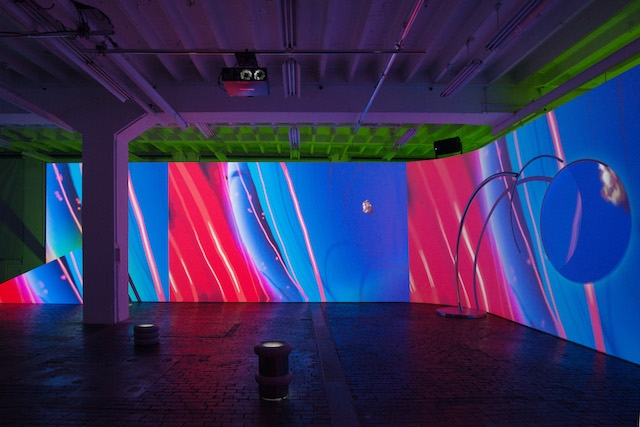This year’s Biennale de l’Image en Mouvement is curated by Andrea Bellini and Andrea Lissoni under the title The Sound of Screens Imploding, invoking cataclysmic change. In their text in the exhibition booklet, the curators conjure a ‘fundamental principle’ around which the show revolves: ‘that moving images now live outside the screen, lingering on in a fascinating kaleidoscope where vision can be shaped even by sound’. In today’s digital sphere, the argument goes, (moving) images have left the fixed screen. At the Biennale, then, 20 newly commissioned works have exploded, perhaps more than imploded, into the main venue at the Centre d’Art Contemporain, Cinema Spoutnik, arts centre Le Grütli online spaces.
Kahlil Joseph’s BLKNWS (all works 2018) is seen first by viewers entering the Centre. The two-channel video is a take on news broadcasts, focusing mostly on influential black people in the US, such as activist Emma González and pianist Cecil Taylor, presenting a nonlinear alternative to the established journalism format whose fallibility has become painfully obvious in recent years. Andreas Angelidakis’s Demos Bar, consisting of seating blocks covered with gold foil, which also clads the walls and handrails in the staircases, comments on the capitalist spectre haunting post-economic crisis Greece, the artist’s home country. On the second floor, Meriem Bennani’s immersive, smart and humorous multichannel video installation Party on the CAPS imagines an island somewhere in the Atlantic Ocean where refugees denied access to the US are held. Set in a not-so-distant future, these would-be immigrants have developed a bustling multiethnic megalopolis, all guided by its mascot, the animated green crocodile Fiona.
Ian Cheng’s text on cognitive evolution, Emissaries Guide to Worlding, is available as an e-book on an iPad and for download in Geneva, while Korakrit Arunanondchai and Alex Gvojic’s No History in a Room Filled with People with Funny Names 5 has a physically palpable effect. The multiple video projections, featuring Boychild and found footage of the 12 Thai boys who were trapped in the Tham Luang Nang Non cave for 18 days in June and July 2018, are surrounded by a thick and smelly earthy substance covering the floor and walls. Tamara Henderson’s Womb Life on the top floor is a surrealist installation including a film of animate objects, a clunky shelf with artist books and a Tinguely/Paik-like array of fragmented sculptural bodies that could also be (re)production machines. Of the screenings at the Cinema Spoutnik, meanwhile, Bahar Noorizadeh’s After Scarcity stands out, a sci-fi essay investigating Soviet cybernetics, highlighting the contradictions between socialist bureaucracy’s slowness and current digital speed. Imagery distorted by Google-tracking tools and bold graphic design letters appearing and disappearing on the screen are accompanied by a screeching soundtrack.
The work that still resonates most with me is Elysia Crampton’s sound environment Orcorara (tres estrellas todos yguales). The Amerindian Aymara musician and composer’s original score is inspired by the writer Joan de Santa Cruz Pachacuti Yamqui Salcamaygua, who lived in the seventeenth century between Lake Titicaca and Cuzco. While attempting to explain Quechua cosmogony to the Spanish colonisers through language, he realised its limitations and resorted to images. In Crampton’s talk during the opening night, she showed Quechua chronicler Felipe Guaman Poma de Ayala’s drawings on an overhead projector, pointing to the opening of a third space in indigenous cosmogony. This third space can be the place of Aymara and LGBTQ resistance, a place beyond binaries, or a place where antimatter disappeared after the implosion. And it can possibly be a place to be created once we leave the confines of the screen. The Biennale poignantly raises the question of what kind of a space that may be, and what we may want it to be.
Biennale de l’Image en Mouvement: The Sound of Screens Imploding at various locations, Geneva, 8 November – 3 February
From the January & February 2019 issue of ArtReview
